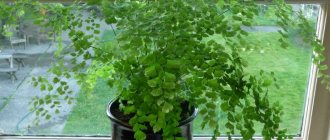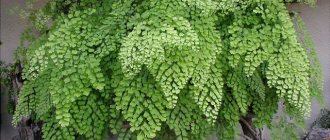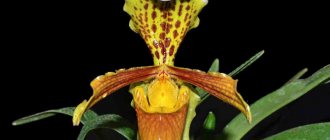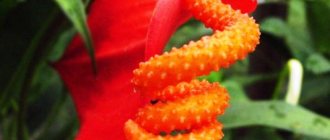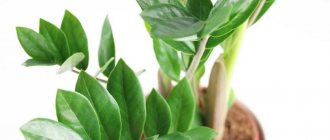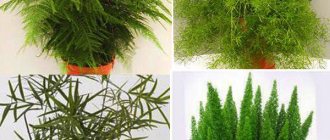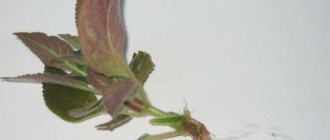What does Venus hair look like, what family does it belong to?
Venus hair (Adiantum capillus-veneris) is usually classified as a member of the genus of ferns, family Pteris. This perennial is characterized by the fact that its leaves are able to repel water.
Adiantum venereal hair
In appearance, the flower is a herbaceous plant 30-40 cm in height with a thin creeping rhizome and openwork leaves, colored bluish or bright green. The leaf blades on a long brown petiole (25 cm in length) can be arranged alternately or oppositely. The sheets have a highly dissected plate with many soft segments.
On a note! With good care, a flower can live at home for more than 10 years.
Common varieties
The most popular types of adiantums for keeping in homes:
- stop-shaped;
- gentle;
- fine-haired;
- Ruddy;
- Beautiful;
- caudate.
Medicinal properties
The leaves of the flower are used to prepare powders and syrups that have expectorant, antipyretic and antimicrobial effects. The tincture is used to treat psoriasis, and dandruff is eliminated using a decoction of adiantum.
Briefly about the history of appearance
The distribution area of this fern is considered to be Brazil and the forests of South America. Wild species can be found in natural conditions in the Caucasus and Crimea. Houseplants are distributed throughout the world.
Medicinal properties of adiantum
Adiantum is considered a harmless plant, but some people are allergic to the spores. In most cases, Venus hair can help in treatment. Keeping fern in the room is especially recommended for people suffering from nervous diseases.
Against cough
50 g of vai pour 0.5 cup. boiling water in a thermos and leave for a day. Strain and drink throughout the day, dividing the portion into 3-4 doses.
For dandruff
Pour 60 g of freshly picked leaves into 400 ml of boiling water and simmer over low heat for 15 minutes. When the broth has cooled, strain it and bring the volume to 1 liter by filling it with boiled water. Rinse your hair after washing your hair.
Features of plant care at home
A distinctive feature of the flower is its rapid growth. This is not difficult to achieve. Venus hair is a flower that does not have high care requirements.
Temperature
Akalifa - home care and description
The optimal temperature for good flower growth is +16… +20 ºС. The plant can withstand cold temperatures down to +10 ºС, but lower temperatures lead to the death of leaves.
Additional Information. A fern pot should not be placed near radiators or heaters.
Lighting
The abundance of sun negatively affects the growth and condition of the flower. In the wild, ferns are most often found in shady areas. At home, suitable conditions for placing a flower will be windows facing east or north. In rooms facing west, it is better to remove the flowerpot from the windowsill into the back of the room.
Lighting the flower of lady's hair
Watering
The frequency of watering depends on the time of year and temperature conditions. On summer days, you need to water the flower 3 times a week. It is important to ensure that the soil always remains slightly moist, and stagnation of water should not be allowed.
Important! Complete drying of the soil leads to the death of the adiantum.
Spraying
If air humidity is within normal limits, then Venus hair does not need to be sprayed. Additional humidification is necessary only if there is intense heat and air humidity is low. In this case, you can regularly spray the flower with warm water. Another effective way to regulate humidity is to place wet stones next to the flower pot.
Humidity
Ferns adapt well to living conditions in an apartment. They can withstand a decrease in air humidity of up to 20%, but it is best to maintain this figure at around 50%. When the air is dry, the plant requires additional moisture.
Priming
Venus hair is one of those types of flowers that prefer loose, nutritious soil. If you prepare the soil yourself, you should mix 2 parts peat and 1 part leaf soil. To improve looseness, you can use a small amount of sand.
Important! To prevent stagnation of water and rotting of the roots, a drainage layer must be laid at the bottom of the pot.
Feeding
During the period of active flower growth (starting in spring), fertilizers are used 2 times a month. Experienced gardeners recommend alternately adding mineral and organic fertilizers.
Transfer
When planting a flower, you should give preference to a clay pot: it better allows the air needed by the roots to pass through. Drainage is poured into 1/3 of the pot, then covered with special soil intended for ferns. As a rule, such a mixture consists of equal parts of turf or leaf humus, peat and fine sandstone.
An overgrown flower is usually replanted after 2-3 years from planting, preferably in the spring. According to the observations of experienced gardeners, adiantum grows better in tight containers: the roots are clamped and do not grow much, thereby stimulating the growth of leaves. When replanting, rotten roots should be removed, carefully, without injuring healthy ones.
Replanting should be done as needed, but not more than once a year. The pot is chosen with a small margin. Suitable soil is breathable, loose, slightly acidic, and enriched with humus.
The ready-made mixture is optimal for ferns. The composition of the soil mixture is as follows: sand, peat, humus soil and leaf soil in equal parts.
How does Venus hair reproduce?
To get a new plant, the following propagation methods are used:
- divide an already mature plant into several parts;
- seeds (spores) are planted.
They differ in effectiveness and duration, so it is worth studying both methods before starting work.
Germination of spores
Before planting, you need to prepare the soil and the spores themselves. Pour soil into a low, wide container, compact it a little and pour boiling water over it. They do this to eliminate pathogenic fungi and bacteria. The spores are placed for some time in a weak solution of potassium permanganate, which increases the resistance of future sprouts to negative environmental influences.
Step-by-step instructions for planting adiantum seeds:
- The spores are evenly scattered in the box. There is no need to dig them in, as this will make the germination process longer and reduce the chance of hatching.
- A film is stretched over the container, thereby achieving a greenhouse effect. Once every few days, the film is opened to spray and ventilate the soil.
- The box with seeds is placed in a warm and bright place. It may take time for seedlings to emerge. In some cases, sprouts appear within 2 weeks, sometimes it takes more than a month.
- After the sprouts appear, remove the film and place the container in a well-lit place (not under direct rays).
Grown strong seedlings can be moved to a pot in a permanent place.
Planting Venus hair
Dividing the bush
It is best to propagate the maidenhair fern by dividing the rhizomes in the spring. To do this, remove the lump of earth from the flower pot and carefully examine the rhizome. It is important to check for rot and damage. If they are found, the bad parts of the roots are cut off with a sharp knife.
In addition, you need to pay attention to the number of growth points. If there are not enough of them on the mother bush, the plant should not be divided. There is a high risk that the flower will not take root.
Immediately after dividing the bush, the roots in the cut areas need to be treated with charcoal. Then all the divisions are planted in prepared pots with soil.
Adiantum propagation
Growing adiantum from spores
Reproduction of adiantum by spores at home is a very complex process. Spores formed from the bottom of the leaves of adult plants must be carefully collected in a paper bag and allowed to dry. Then, the spores are evenly placed on fluorine and covered with glass. The spores must be regularly moistened by spraying with fluoride. After a month, moss begins to form, from which small sprouts will subsequently appear. The sprouts must be divided by planting in different pots. It is recommended not to remove the glass cap from the sprout during the first stages of adiantum growth.
Reproduction of adiantum by dividing the bush
Another, easier option for propagating adiantum is to divide the bush. To do this, you need to carefully separate the existing bush and its roots. This procedure must be performed very carefully so as not to injure the roots and not ruin the flower. When planting, the root collar should not be very deep, otherwise the roots will begin to rot.
Root division
By dividing the root, only mature, or preferably old, ferns that have already begun to lose their decorative properties are propagated. Dividing the root is not such a harmless procedure. If the operation is unsuccessful you may lose the mother plant. And the survival rate of separated parts is not always high. The root of the adiantum is very sensitive, as is the whole plant.
- In spring, remove an adult adiantum bush from the pot.
- Clean the root system from the substrate.
- Using a sharpened sterile knife, cut the rhizome into pieces so that at least one leaf remains on each.
- Plant the parts in separate containers filled with light soil, sterilize it first.
- Spray the seedlings and moisten the soil.
- Place new plants in a shady and warm place.
- Apply foliar feeding through spraying.
- Adiantum seedlings develop slowly. Like adult ferns, they need high humidity, diffused light and warmth.
Possible problems in cultivation and diseases
If not properly cared for, the flower begins to dry out and die. If you notice these changes in time, adjusting the maintenance conditions will help restore the plant.
The leaves are turning pale
Venus hair can change the color of leaves. The color turns from bright green to whitish or yellowish. Reasons for such changes:
- excess light or exposure to direct sunlight;
- lack of fertilizers;
- too frequent watering or stagnation of moisture.
The tips of the leaves are drying out
If the tips of the leaves become dry, this indicates extreme heat and lack of humidity. To eliminate the signs, you need to spray the plant more often.
Pests
Adiantum is relatively rarely exposed to diseases and pest attacks. This feature can be explained by the fact that its leaves have bactericidal properties. Among the insects that can settle on the plant are scale insects and fern aphids. To eliminate parasites, the flower should be treated with insecticides for indoor plants.
Monoliosis
This disease is one of the main reasons why cherry branches and leaves dry out. Monilial burn is characteristic of all stone fruits. The first signs appear already in June. The disease is caused by a fungus that has been stored in mummified berries since the beginning of winter and affects the branches. Gardeners who know little about moniliosis believe that the cause of drying is winter freezing or side effects from chemical treatment.
The distinctive features of moniliosis are:
- withering and drying of flowers;
- darkening of leaves to black;
- darkening young shoots;
- drying new twigs on a cherry tree.
Cherries dry out after the start of flowering due to the action of fungal spores. During the flowering period, pests get on the pistils. When germinating, the fungus attacks the blood vessels and leads to further development of the disease.
Old cherry varieties are prone to the disease, such as:
- Lyubskaya;
- Vladimirskaya;
- Felt.
Possess immunity:
- Shpanka;
- Krasnokutskaya;
- Anadolskaya.
Forms of the disease
There are 2 forms of moniliosis. The first is a monilial burn. If the winter was warm, then in the spring symptoms of the disease appear. The virus is the main reason why cherry leaves turn black and dry. The fungus also affects young branches, shoots and flowers. Through the stigmas of the pistils, the fungus enters the wood and destroys it from the inside. The ends of the branches begin to dry out. By the time the cherry blossoms have faded, it is almost impossible to revive the plant. After some time, the flow of moisture into the tree stops, and the tips of the branches dry out.
Sometimes resin may begin to ooze out. It flows down the branches and forms dense dry balls. This phenomenon is called gum bleeding.
The second form of the disease is gray rot. This type of disease affects berries. The fungus penetrates through mechanical damage or wounds caused by insects. The berries turn black, spots appear that cover the entire fruit. Sporulation pads form on them. This symptom is often attributed to fruit rot, but monoliosis is characterized by a chaotic arrangement of formations. Fruit rot pads are arranged in circles. Affected berries shrivel and dry out.
Treatment options
The disease spreads very quickly, so treatment measures must be carried out on all plants. Treatment with chemicals is best done on dry days. For the tree to fully absorb the drugs, several hours without rain are required.
It is recommended to use special means against minoliosis.
- "Abiga Peak". The product is intended for spraying cherries during the growing season. For 10 liters of water you need 45 g of product.
- Bordeaux mixture. Processing is carried out during the same period. In early spring, you can use Bordeaux mixture “Extra”.
- "But". It is used when cherry blossoms dry out. The product is intended for use in combination with other fungicides.
- "Cupid". The product is used to treat cherries after flowering, if the foliage dries out and the flowers die. Can be used no more than once a week.
- "Kuproksat". Spraying is done after buds open. The interval between treatments should be at least 10 days.
Signs and superstitions
It is best to place a lady's hair in a woman's bedroom. According to superstitions, this fern enhances feminine energy. However, it will also be appropriate in any other home or office, since the flower eliminates negativity and gives the inhabitants of the room peace of mind and self-confidence.
The plant looks gorgeous even without flowers
For flower growers looking for flowering plants, the fern fern is not suitable for flowering, since the fern does not form buds. However, this feature does not at all affect the beauty of the perennial. The unusual look is provided by carved leaves.
